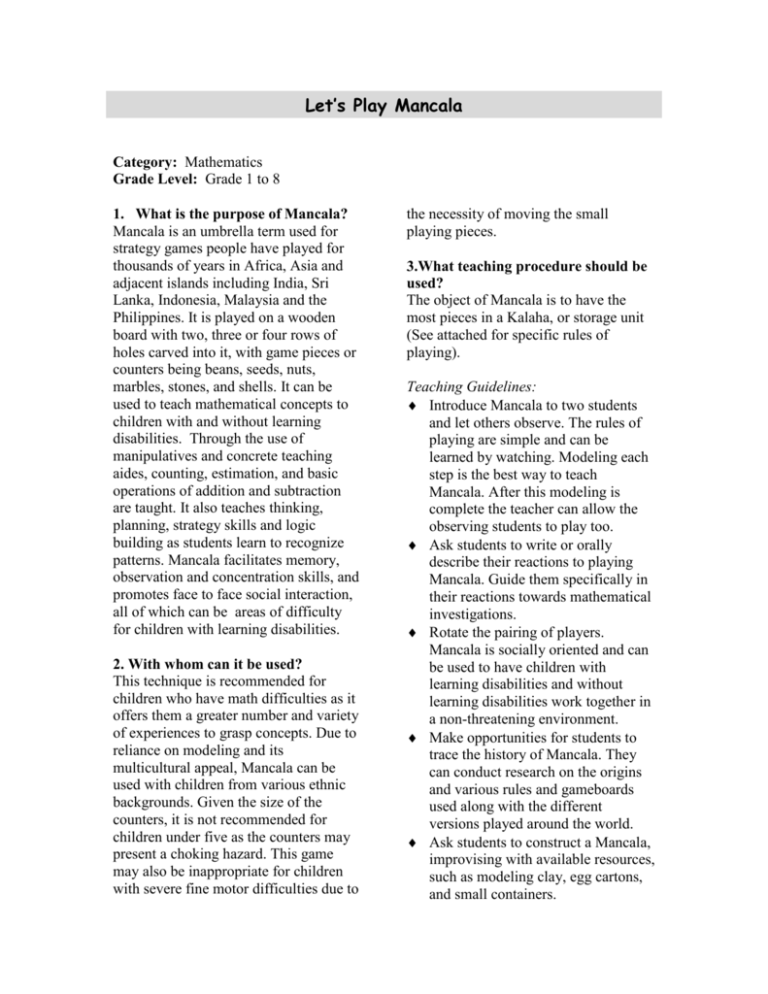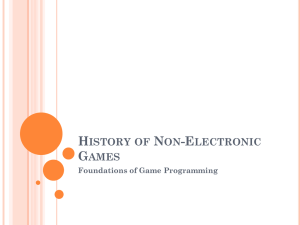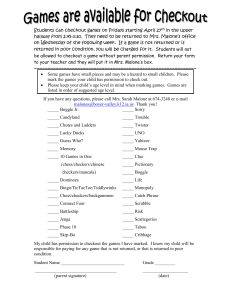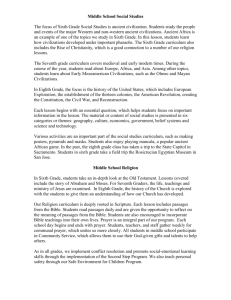Mnemonic Multiplication Fact Instruction
advertisement

Let’s Play Mancala Category: Mathematics Grade Level: Grade 1 to 8 1. What is the purpose of Mancala? Mancala is an umbrella term used for strategy games people have played for thousands of years in Africa, Asia and adjacent islands including India, Sri Lanka, Indonesia, Malaysia and the Philippines. It is played on a wooden board with two, three or four rows of holes carved into it, with game pieces or counters being beans, seeds, nuts, marbles, stones, and shells. It can be used to teach mathematical concepts to children with and without learning disabilities. Through the use of manipulatives and concrete teaching aides, counting, estimation, and basic operations of addition and subtraction are taught. It also teaches thinking, planning, strategy skills and logic building as students learn to recognize patterns. Mancala facilitates memory, observation and concentration skills, and promotes face to face social interaction, all of which can be areas of difficulty for children with learning disabilities. 2. With whom can it be used? This technique is recommended for children who have math difficulties as it offers them a greater number and variety of experiences to grasp concepts. Due to reliance on modeling and its multicultural appeal, Mancala can be used with children from various ethnic backgrounds. Given the size of the counters, it is not recommended for children under five as the counters may present a choking hazard. This game may also be inappropriate for children with severe fine motor difficulties due to the necessity of moving the small playing pieces. 3.What teaching procedure should be used? The object of Mancala is to have the most pieces in a Kalaha, or storage unit (See attached for specific rules of playing). Teaching Guidelines: Introduce Mancala to two students and let others observe. The rules of playing are simple and can be learned by watching. Modeling each step is the best way to teach Mancala. After this modeling is complete the teacher can allow the observing students to play too. Ask students to write or orally describe their reactions to playing Mancala. Guide them specifically in their reactions towards mathematical investigations. Rotate the pairing of players. Mancala is socially oriented and can be used to have children with learning disabilities and without learning disabilities work together in a non-threatening environment. Make opportunities for students to trace the history of Mancala. They can conduct research on the origins and various rules and gameboards used along with the different versions played around the world. Ask students to construct a Mancala, improvising with available resources, such as modeling clay, egg cartons, and small containers. Monitor students as they play Mancala to ensure they are playing properly and safely. 4. What are the benefits of playing Mancala? This multicultural board game not only facilitates the learning of math concepts, but is a fun, novel way to learn. The material needed to play can be inexpensive and makeshift boards and counters can be constructed, carried and stored easily. This game is very social and helps build peer interaction and friendships. As the rules are simple, parents can be taught and can play with their children at home as well, further reinforcing math skills. 5. In what kind of setting can Mancala be used? This game can be used in both a home or school setting. It requires at least two players and can incorporate a small number of players. 6. To what extent has research shown Mancala to be useful? Research by de La Cruz, Cage, and Lian (2000) demonstrated that teachers found Mancala to be beneficial to students with math learning disabilities. In accordance with research demonstrating the positive effects of using concrete experiences before teaching students abstract concepts (the concrete-semi-concreteabstract sequence) (Mercer & Mercer, 1998), this strategy affords teachers the opportunity to provide a wide range of choices. Specifically, Mancala was found to improve basic math concepts such as adding, subtracting, counting and estimation. Additionally, it facilitated memory, observation and concentration, and encouraged positive social interaction, all potential areas of weakness for children with learning disabilities. Another benefit of this strategy was the promotion of peertutoring skills. As research has demonstrated peer tutoring to be a beneficial strategy for enhancing math learning (Jordan, 1995), this method of teaching provided not only positive reinforcement from peers but alternative teaching models as well. Overall, teachers reported that students found Mancala to be fun, novel and a good vehicle for developing multicultural awareness. References 1. de la Cruz, R., Cage, C., & Lian, J. (2000). Let’s play mancala and sungka: Learning math and social skills through ancient multicultural games. Teaching Exceptional Children, 32, 38-42. 2. Jordan, N. (1995).Clinical assessment of early mathematics disabilities: Adding up the research findings. Learning Disabilities Research and Practice, 10, 59-69. 3. Mercer, C.D. & Mercer, A.R. (1998). Teaching students with learning problems (5th ed.). Upper Saddle River, N.J: Prentice Hall. In addition, see (http:// www.iserv.net/~central/Games/ MANCALA/mancala.html) for instructions on how to play Mancala. Reviewed by: Chandi Fernando








